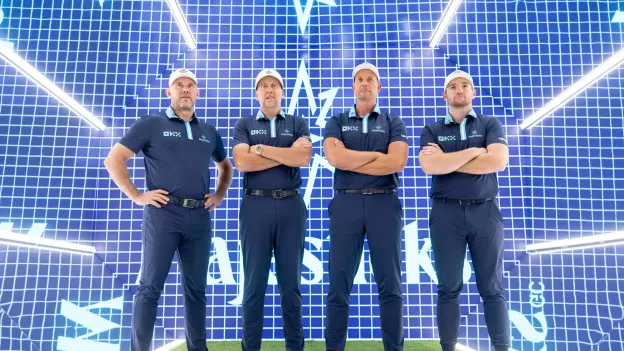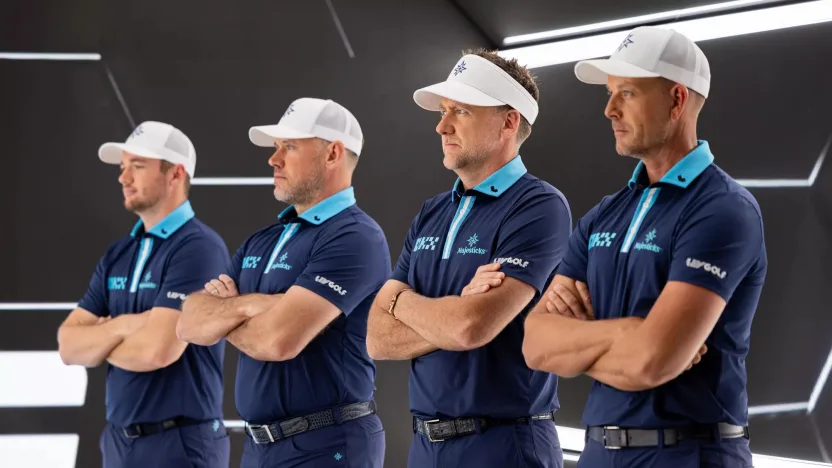MAJESTICKS LEAN INTO ANALYTICS IN HOPES OF MAKING NOISE IN 2024
Jan 23, 2024 - 2:27 PMWritten by: Mike McAllister

From a business standpoint, the UK-centric Majesticks GC may very well be the most successful team in LIV Golf. Alas, their on-course performance hasn’t kept pace.
From a business standpoint, the UK-centric Majesticks GC may very well be the most successful team in LIV Golf. Four official corporate partners, including global sponsor OKX. The launch of their Little Sticks community impact program. A robust social content plan – including the recently launched “Camp Confidential” docuseries – that now reaches 100,000 followers across all platforms.
Alas, their on-course performance hasn’t kept pace.
The Majesticks were the only team among the 12 in last season’s LIV Golf League that failed to produce a podium finish, either as a team or individual. They finished next-to-last in points during the 13-tournament regular season, and next-to-last at the season-ending Team Championship in Miami.
Given that the three co-captains – Englishmen Ian Poulter and Lee Westwood, and Sweden’s Henrik Stenson – each have golfing resumes that meet the qualification standards for the World Golf Hall of Fame, it’s both a surprise and a disappointment that team success seemed so elusive.
“In this business model that we have, part of a good business is obviously performance,” Poulter said. “We didn’t perform anywhere near what we would’ve liked.”
The numbers show the struggle. But it’s the numbers that the Majesticks are now turning to in hopes of showing improvement in the 2024 season, which begins next week at LIV Golf Mayakoba in Mexico.
This offseason, analytics has been a point of increased emphasis for the team, which also brings back Sam Horsfield for a third season. During a team week in Orlando, Florida in early December, the Majesticks and their staff poured off statistics and identified areas for improvement, utilizing a third-party data collector and analysis company to hone in on specifics.
“It’s good to have the numbers,” Stenson said. “Given the experience we have and obviously being the oldest team around, I guess, when you add the ages up, we should know what we need to do at this stage. But it’s always good to have certain things confirmed – and there might be the odd thing that you thought, ‘Oh, really, I didn’t know that.’
What did the numbers show?
For the 50-year-old Westwood, who finished inside the points (top 24) in just three regular-season starts, it was his wedge play.
“That’s a huge part of the game, especially when you’re trying to score low,” he said. “You have a lot of shots from 140 yards to 70, and I was really poor in that area. Working on my wedge game coming up is going to be key for me.”
For the 48-year-old Poulter, who had three top-15 finishes but none inside the top 10, it was elements of his iron play – specifically outside 140 yards
“Inside 140, I was great last year; outside 140 to 220, that was a disappointing statistic,” Poulter said. “Figuring out why that would be, comparing that to previous years, to data that we have from 2010, 2012, 2016, ’17, ’18 – years that you felt that was a good part of your game.
“Then kind of having a look at why. What were we doing differently back then? What practice routines were in place back then? So, just trying to pull apart every little aspect and see if we can identify an area that’s been missing in the last 18 months.”
Poulter said the data prompted him to evaluate the shafts in his irons, and so he spent part of the offseason in extensive testing. He’s also tweaked some of his loft angles.
For the 47-year-old Stenson, who had the team’s three best individual point performances last season, including a fifth at LIV Golf DC, it’s his mid-range putting.
“For myself, short-range putting has always been pretty strong and long-range putting has been normally OK,” he said. “I normally don’t convert enough between 9 and 15 feet, so that’s kind of an area which is more low-hanging fruit for me. You have quite a lot of putts in that range.”
Stenson noted that statistical rankings can be deceiving – which is one reason why having a dedicated analytics group can be extremely valuable.
“Out of 48 or 50 players, you can be 45th in short-range putting, but that might mean you’re missing one putt more inside 3 feet compared to everybody else,” he explained. “If it’s the wrong one, it’s obviously detrimental, but over the course of the season, that might not be. If you’re going from 40th to 20th in putting inside 3 feet, that might save you half a shot for the year.
“But if you go from 40th to 20th between 10-15 feet with the number of tries that you have, it can make a massive distance.”
Understanding what the data says and pinpointing areas to improve is one thing. Now it’s just a matter of executing. Will it happen in 2024?
There are no guarantees, of course. But the Majesticks are determined to make some noise – not just for their own sake, but also for their partners as well as their large number of fans who follow the team and have patiently awaited a champagne celebration result.
“Look, we're all world-class players and we've been at the top of the game for a very long time,” Poulter said. “So, if we can nick half a percent on certain aspects across the board, then that in itself will give us the opportunity to perform better.”

